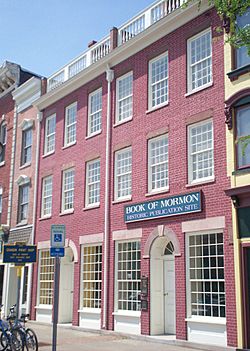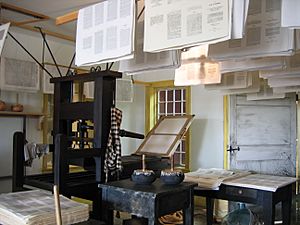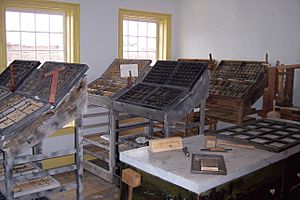Book of Mormon Historic Publication Site facts for kids
Quick facts for kids Book of MormonHistoric Publication Site |
|
|---|---|
 |
|
| Location | 217 East Main Street Palmyra Village, Wayne County, New York, |
| Elevation | 575 feet (175 m) |
| Years of significance | 1829–1830 |
| Built | 1828 |
| Restored | 1994–1998 |
| Governing body | The Church of Jesus Christ of Latter-day Saints |
| Lua error in Module:Location_map at line 420: attempt to index field 'wikibase' (a nil value). | |
The Book of Mormon Historic Publication Site is a special place in Palmyra, New York, USA. It includes the E. B. Grandin Building and other nearby buildings. This is where Egbert B. Grandin printed and sold the very first copies of the Book of Mormon.
Because this building is so important to Latter Day Saints, The Church of Jesus Christ of Latter-day Saints (often called the LDS Church) bought it in 1978. In the mid-1990s, the church fixed up the Grandin building. They also updated other buildings nearby to create a place for visitors.
Contents
The History of the Grandin Building
Egbert B. Grandin's printing business was in the building furthest to the west. This group of buildings was built in 1828. It was located between Palmyra's Main Street and the Erie Canal.
Grandin's bookshop was on the first floor. His book binding area and a lawyer's office were on the second floor. The printing machines, including two printing presses, were on the third floor. In 1829, Grandin was asked to print the Book of Mormon. At that time, he also published a newspaper called The Wayne Sentinel.
Grandin later closed his printing business. The building has been home to many different businesses since then. Over the years, the building was changed many times. New walls, stairs, and even plumbing were added.
The Church of Jesus Christ of Latter-day Saints bought the E. B. Grandin Building in October 1978. Soon after, the first floors of both buildings were made into a visitors' center. During a local celebration, computers were set up there. Visitors could use them to research their family history.
Bringing the Building Back to Life
In December 1993, the leaders of the LDS Church said the visitors' center would close. This was so the building could be restored. The visitors' center would also be made better. The center closed on November 20, 1994. This allowed research and restoration work to begin.
Before and during the restoration, a lot of research was done. This included looking into the building's history and doing archaeological digs. Workers found much of the original plaster and wood inside. The original floors and windows were also still there. They even found ink smudges on the third-floor walls. These are believed to be from when Grandin worked there.
On the outside, decorations that were not original were removed. Old layers of paint were also taken off. It was discovered that the bricks were originally painted with a red glaze. This made the building look very neat. During the restoration, a similar red glaze was painted on the building. Old additions at the back of the building were removed. A new part was built there to be part of the visitors' center.
Gordon B. Hinckley, who was the president of the LDS Church, dedicated the restored building. This happened on March 26, 1998. This date was also the anniversary of when the Book of Mormon first went on sale. The building is open for free tours every day. Church missionaries give these tours. Grandin's printing press was copied at a museum in Provo, Utah.
Printing the Book of Mormon
When Joseph Smith, Jr. first asked Grandin to print the Book of Mormon, Grandin said no. He thought it was too risky and didn't believe in the book. Smith then looked for a printer in Rochester. He found Elihu F. Marshall, who was willing to print it. But before signing with Marshall, Smith asked Grandin again. He told Grandin the book would be published anyway. Grandin then agreed to print 5,000 copies.
Later, Grandin worried again and stopped printing. He needed a $3,000 payment to continue. Martin Harris, a farmer who believed in Smith's revelations, mortgaged his farm for the money. This allowed the printing to continue.
Grandin announced in his newspaper on June 26, 1829, that he would publish the Book of Mormon. This would happen once the translation was finished. Oliver Cowdery prepared a copy of the book's manuscript. Grandin bought special type for the printing. The main typesetter, John H. Gilbert, said the manuscript was "closely written and legible." But it had no punctuation marks. Gilbert said he added punctuation and capitalization in the evenings.
To print the book, Grandin used a Smith Improved Printing Press. This was a modern press for its time. The original press Grandin used is now in the Church History Museum in Salt Lake City, Utah.
In October, Smith wrote that local people were "very much excited" about the book. But it was not the kind of excitement he hoped for. A local newspaper called the book "the greatest piece of superstition." Another newspaper, the Palmyra Reflector, started reprinting parts of the book to make fun of it. This happened because the editor used Grandin's press. Smith had to threaten legal action to stop it.
Many local people thought the Book of Mormon was wrong. They tried to get Grandin to stop printing it. When that didn't work, they agreed to boycott the book. This meant they would not buy any copies.
The Wayne Sentinel announced on March 26, 1830, that the Book of Mormon was on sale. It took eight men and boys almost eight months to print 5,000 copies. They worked 12 hours a day, six days a week. After the book went on sale, the boycott began. It worked, and very few books were sold. Martin Harris, who paid for the printing, tried to sell the books himself. But he said, "no Body wants them."
Today, copies of Grandin's first edition of the Book of Mormon are very valuable. They are popular items for collectors. For example, a copy sold for $58,000 in 1999. Another copy sold for $180,000 in 2007. In 2014, an original edition was valued at $100,000 on a TV show called Antiques Roadshow.
Images for kids




